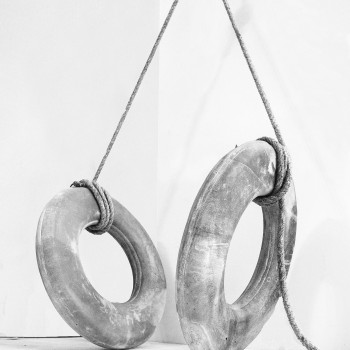Hope: Artwork by Aithan Shapira
The product of my genius and my misery, and that which I have [created] in my greatest distress, is that which the world seems to like best. —Schubert
“Hope is integral—some is collected, some is inherited. I want, I think we all want, for it to be a simple, beautifully elegant thing, but the more you draw from it, it begins to look more like despair, or re‐purposed despair. There is a similar reasoning behind starting a new work of art.” —Shapira
Hope “casts” light on the gravity of Israeli‐American artist Aithan Shapira’s recent work. Shapira asks what hope looks like today, and has created a universal symbol from an abandoned life preserver. His subject matter spans more than a decade across three continents tackling conflicting fields of view, whether simultaneously addressing two sides of a wall or matters of migration or of false hope. Over the years, the abandoned life preserver has evolved in his work: one cut from discarded cardboard, another painted in a fox trap, and in this recent series, he cast hundreds in concrete for those who it is too late to save.
For Shapira, hope anchors 2015 political, economic, and environmental campaigns; it is the driving force for personal ambitions under the stresses of the current global climate; hope is simultaneously the aspiration to end wars and the catalyst to begin them—a measure of human life. “It’s the poetry of human potential,” he remarks about the exhibit. Hope is a vision for art and our generation’s ability to make societal and cultural change. “My work is not about me, it is a mirror of us, and it does not show what we are but reflects what we can become.”
I’ve cast concrete flotation devices that maintain a permanent inflatedness, yet they would kill rather than save. Making a concrete life preserver is both a creative act and a communicative, sensual one. In the studio there is a conflict against the real and against the unreal, the fight against the abstract part of art—the not visible—and the things that do not go together yet must. In this active negotiation, hope is present in abundance, and the conflict is similar outside the allegory of the studio.
We understand hope as a positive recognition—or a negotiation—of an always incomplete imperfection. We confront this palpable, heavy form we construct both individually and in the communities we create. These concrete life preservers were constructed while asking what hope looks like, visually and physically, today.
Making these concrete preservers in the studio has been like plotting some action or revolution, at times not knowing when you will truly be prepared. When I was living in London as a student at the Royal College of Art, I would regularly walk across the Thames via Hungerford Bridge. On an adjacent pillar supporting the bridge, and out of any possible human reach, rotted an abandoned life preserver. The poetry of the scene had me drawing on site for hours each week. These notebook drawings translated to eight‐foot drawings on canvas, and eventually into similarly‐sized collographs and etchings printed on presses that were given to the Queen in the early 1850s. After four years, each life preserver was another confession. Even as prints that began as the three-foot reliefs in cardboard, they were limited in dimension, literally being flattened. I needed to lift them, and for them to be heavy.
‘Nested’, ‘Coupled’, ‘Shattered’, ‘Balanced’, ‘Reused’—these are the ways we negotiate hope. Hope is also a reason to begin the next work of art.
Hope exhibits eighteen key works from Shapira’s Hope series curated in three rooms. Eighteen is a significant number in Jewish culture, language and tradition that symbolizes chai or ‘life’. In conjunction with this body of work is a catalogue of collected words on hope from influential and well‐respected individuals spanning a variety of fields. The artist collaborated with the voices of our generation to share their vision for ‘hope’ from their respective fields in an effort to begin this important conversation on the challenges we have overcome together and those we have yet to face.
These concrete symbols were first exhibited as part of here, without, a group exhibition at Harvard University’s Sackler Museum in February 2015 and they will travel after the exhibition at The Florida Holocaust Museum in St. Petersburg, Florida, as part of an upcoming solo show to the JCC Manhattan, NY, in the fall of 2015.



